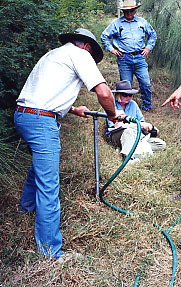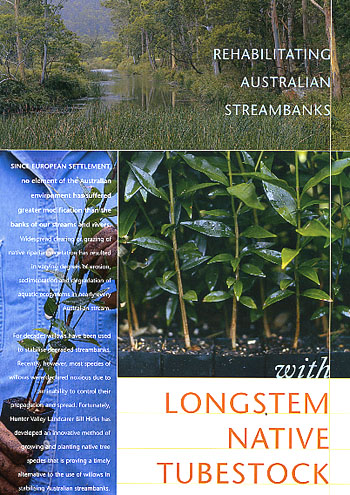Although native trees were used in the revegetation of the stream (environs, greater use was made of the willow. This was because it was capable of fast growth and had strong resistance to wash away in flood conditions as a result of the deep planting of the cuttings. The Willow was particularly effective in stabilising the stream banks. The desire to find an alternative to the willow, because it was environmentally out of place and ecologically damaging, has been heightened in recent years by the increasing trend for willows to extensively self propagate in stream-beds from the germination of seed. In some river systems this has reached serious proportions and the enormous willow population is threatening the integrity of the river channels. Many willow species are now being declared noxious and are therefore no longer an option, even if their violation of the ecology could be tolerated. At the National Stream Management Conference, river management authorities from across Australia, conclusively adopted that willows should no longer be considered as a tool in stream management programs. It is not possible to plant Australian native trees as large hardwood cuttings. Historically when native trees were used in riparian revegetation programs it was generally carried out using tubestock, i.e. plants grown for about six to seven months in 50 mm x 130 mm plastic forestry tubes. These trees when planted out would be in the order of fifteen centimetres long. However experience had shown that tubestock is vulnerable to wash away from floods and also subject to heavy losses as a result of drying out in hot dry periods. This then created a serious dilemma .... how to reliably replace willow plantings with appropriate native species. The answer turned out to be longstem native tubestock, a new and innovative method of growing native trees to replicate all the advantages previously attributed only to willows. Over a number of years, Bill Hicks, an electrical engineer, with a lifelong interest in the ecology and in the propagation of Australian native plants, had been independently working on developing a system of growing and planting native trees that would replicate all the favourable characteristics of willows, particularly the ability to be deeply planted in riparian environments.
Longstem tubestock is a tree (or under-story shrub) grown in the same standard 50mm square tree tube used in the growing of standard tubestock. But in the case of Longstem tubestock the plant is grown to a length similar to that of an average willow cutting, a length of one metre or more. Being developed within the dimensions of the 50mm tube, the plant root-ball is small enough to be inserted into a deep hole not dissimilar to that provided for the deep planting of a willow cutting. About three quarters of the length of the plant is placed below the soil surface. In achieving this result two traditional horticultural principles have been overturned (1) that the growing of an advanced plant in a restricted container results in root deformation and (2) that deeply immersing a rooted plant below the soil level in which it was previously growing, results in tissue disease to the stem of the plant which will either destroy the plant, or degrade its development. Both of these assertions have been proven incorrect by the longstem system developed by Bill Hicks. By developing a special fertilizer regime with particular emphasis on trace elements the Longstem plants grow to the required size within the small container with an ideal, undistorted, root structure. Additionally the deeply immersed plant stems are totally unaffected by the deep planting.
Becoming aware of the Longstem system, the Hunter Catchment Management Trust and the Department of Land and Water Conservation in the Hunter Region, decided to adopt the technology for their major revegetation programs in the Hunter Valley. Over the past few years tens of thousands of Longstem trees have been planted along the Hunter River and its subsidiaries. These plantings have achieved outstanding results in growth and reliability and of course have set in train the restoration of the original native ecology throughout the Hunter. Following the success in the Hunter region, Longstem tubestock is now being used many other areas throughout Australia. A number of additional advantages have been observed. The deep immersion of the root ball has the effect of placing the root structure below the hot, dry strata in the immediate surface area of the soil, a condition that is damaging to surface planted standard tubestock. It also protects the root structure from the frosty, sometimes frozen surface soil, in winter. It is very often the freezing of the root that causes the plant to die, rather than the freezing of the plant superstructure. The protection of the root system enables the plant to re-shoot when the growing season re-commences. The deep immersion also places the root system below the area of weed competition and allows accelerated growth compared with the alternative planting procedures. Longstems are now also being used for arid region plantings and for use in re-vegetation of areas affected by a high level of salinity. The Longstem technology is equally applicable to plants from other regions and it is now being used areas outside of Australia. However, the most important outcome of the longstem technology is that there never need be another willow planted along Australia's river systems. From Native Plants for New South Wales, newsletter of the Australian Plants Society (NSW), October 2002. Bill Hicks has produced a video: Longstem Native Tubestock: The Alternative to Willows for Streambank Erosion Control, which can be obtained for a cost of $33 (includes GST) from the Department of Infrastructure, Planning and Natural Resources, Phone 1300 305 695.  [Front Page] [Features] [Departments] [Society Home] [Subscribe] Australian Plants online - March 2003 |
||||||||||||||||




